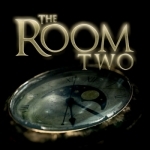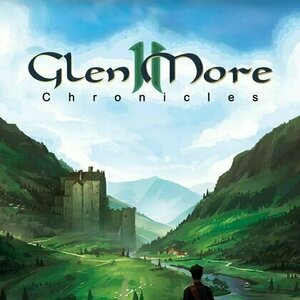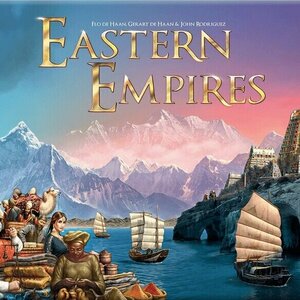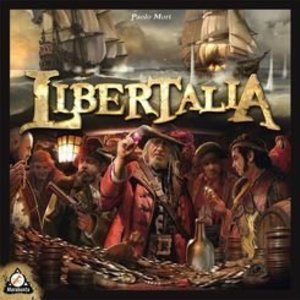Search
Search results
Purple Phoenix Games (2266 KP) rated Libertalia in Tabletop Games
Sep 5, 2019 (Updated Dec 2, 2019)
(Sung to the tune of “Rainbow Connection”) Why are there so many games about pirates? Why do I love them so much? (end music) Well I will tell you. Libertalia is one of the first pirate games I ever collected and played. I was finally able to introduce it to Laura recently and you can see by the ratings graphic that she really enjoyed it too. But why? It’s just another pirate game, right?
Libertalia pits the players against each other to become the wealthiest pirate captain by manipulating crew members and using their strengths to secure the almighty booty. The game takes place over three weeks, and each round of play is equal to one week. There are six playable days where captains will be selecting crew members to contribute their special abilities for gain and treachery to other captains.
DISCLAIMER: I do not intend to cover every single rule included in the rule book, but will describe the overall game flow and major rule set so that our readers may get a sense of how the game plays. For more in depth rules, you may purchase a copy from the publisher directly or from your FLGS. -T
To setup the game lay out all boards in the center of the table, choose which color pirate you would like to represent and take all corresponding color components, fill the booty spaces on the bottom of the ship board with enough booty tokens for one per player per box, and give each player ten doubloons worth of starting money. The youngest player now shuffles their deck thoroughly and deals themselves nine random cards. They player then reads out the numbers of cards they have drawn so that all players will have a matching hand of cards of the same numbers. Example: the youngest player draws 9 – 12 – 16 – 19 – 20 – 21 – 22 – 25 – 29. Each player will remove those exact cards from their decks to form the matching starting hand. You are now ready to play!
All captains will simultaneously choose one card from their hand to play for the “day.” The youngest player collects all played cards and arranges them numerically from lowest to highest (with numbers in the gray box area breaking ties). The Day now begins with any Day time specific abilities triggering on cards that show the matching Day symbol beginning with the lowest numbered card and ending with the highest (we will call it “initiative” for the purposes of this review). It could be taking doubloons, or otherwise affecting other cards. Once complete, the booty tokens for that Day are claimed in reverse initiative order (highest to lowest) and Dusk abilities are triggered. When all captains are satisfied with their booty (or oftentimes NOT satisfied) any Night special abilities are triggered and performed as well as the Cutlass and Spanish General token abilities. Those that have been discarded (slain) are placed under the play mat on the left side (where one can find the graveyard), and all surviving pirates retire to the “Den” where they may still be of service at the end of the week or even end of the game. At the end of the sixth Day/Night any pirates alive in the Den with a Day of Rest anchor icon will trigger their special abilities. The youngest player then draws and relays the next six cards to setup the next round and you are off for week #2. Play continues in this way for six Days over three Weeks.
Components. The game has a fair amount of different components, but they are all quite good. The punchboard components (boards, booty tokens, doubloons) are all a good thickness and quality. They look so good that my 3-year-old son wanted to play with them and add them to his gold doubloon collection. Yes, he has a gold doubloon collection in a treasure box. The cards and play mats are of good quality too. The art on this game is absolutely stellar. It is so realistic and wonderful that you actually get caught up in the piratey theme and wanting to score that sweet booty. (I’m done with the booty jokes I think)
So this was my first pirate board game I ever purchased, and I obviously still have it in my collection, so it’s good right? Absolutely! This is one of the best pirate-themed games I have ever played and I am certainly not alone. As of today Libertalia is ranked #2 in pirate themed games on BGG by rank (I believe Friday is disqualified because that’s not really a pirate game to me). The interplay between the pirates you can choose in your limited hand each round, but captains may choose different combinations of pirates to use each hand and each round that you sometimes forget that they had not yet used their Surgeon, and this is such a great time for them to use it. Bloody sneaky powder monkey!
Libertalia is that rare game that you instantly fall in love with, and when you try to share your love of it with others, you can see their eyes light up over the brilliance of design and deep appreciation of the art and components. If I ever get into seriously blinging out my games, you better believe Libertalia will be one of the first I treat. Purple Phoenix Games gives Libertalia a buccaneer’s loot of 21 / 24.
Libertalia pits the players against each other to become the wealthiest pirate captain by manipulating crew members and using their strengths to secure the almighty booty. The game takes place over three weeks, and each round of play is equal to one week. There are six playable days where captains will be selecting crew members to contribute their special abilities for gain and treachery to other captains.
DISCLAIMER: I do not intend to cover every single rule included in the rule book, but will describe the overall game flow and major rule set so that our readers may get a sense of how the game plays. For more in depth rules, you may purchase a copy from the publisher directly or from your FLGS. -T
To setup the game lay out all boards in the center of the table, choose which color pirate you would like to represent and take all corresponding color components, fill the booty spaces on the bottom of the ship board with enough booty tokens for one per player per box, and give each player ten doubloons worth of starting money. The youngest player now shuffles their deck thoroughly and deals themselves nine random cards. They player then reads out the numbers of cards they have drawn so that all players will have a matching hand of cards of the same numbers. Example: the youngest player draws 9 – 12 – 16 – 19 – 20 – 21 – 22 – 25 – 29. Each player will remove those exact cards from their decks to form the matching starting hand. You are now ready to play!
All captains will simultaneously choose one card from their hand to play for the “day.” The youngest player collects all played cards and arranges them numerically from lowest to highest (with numbers in the gray box area breaking ties). The Day now begins with any Day time specific abilities triggering on cards that show the matching Day symbol beginning with the lowest numbered card and ending with the highest (we will call it “initiative” for the purposes of this review). It could be taking doubloons, or otherwise affecting other cards. Once complete, the booty tokens for that Day are claimed in reverse initiative order (highest to lowest) and Dusk abilities are triggered. When all captains are satisfied with their booty (or oftentimes NOT satisfied) any Night special abilities are triggered and performed as well as the Cutlass and Spanish General token abilities. Those that have been discarded (slain) are placed under the play mat on the left side (where one can find the graveyard), and all surviving pirates retire to the “Den” where they may still be of service at the end of the week or even end of the game. At the end of the sixth Day/Night any pirates alive in the Den with a Day of Rest anchor icon will trigger their special abilities. The youngest player then draws and relays the next six cards to setup the next round and you are off for week #2. Play continues in this way for six Days over three Weeks.
Components. The game has a fair amount of different components, but they are all quite good. The punchboard components (boards, booty tokens, doubloons) are all a good thickness and quality. They look so good that my 3-year-old son wanted to play with them and add them to his gold doubloon collection. Yes, he has a gold doubloon collection in a treasure box. The cards and play mats are of good quality too. The art on this game is absolutely stellar. It is so realistic and wonderful that you actually get caught up in the piratey theme and wanting to score that sweet booty. (I’m done with the booty jokes I think)
So this was my first pirate board game I ever purchased, and I obviously still have it in my collection, so it’s good right? Absolutely! This is one of the best pirate-themed games I have ever played and I am certainly not alone. As of today Libertalia is ranked #2 in pirate themed games on BGG by rank (I believe Friday is disqualified because that’s not really a pirate game to me). The interplay between the pirates you can choose in your limited hand each round, but captains may choose different combinations of pirates to use each hand and each round that you sometimes forget that they had not yet used their Surgeon, and this is such a great time for them to use it. Bloody sneaky powder monkey!
Libertalia is that rare game that you instantly fall in love with, and when you try to share your love of it with others, you can see their eyes light up over the brilliance of design and deep appreciation of the art and components. If I ever get into seriously blinging out my games, you better believe Libertalia will be one of the first I treat. Purple Phoenix Games gives Libertalia a buccaneer’s loot of 21 / 24.
Matthew Krueger (10051 KP) rated Coup in Tabletop Games
Jul 17, 2020 (Updated Jul 18, 2020)
Easy to Learn (3 more)
Lying about who you are
Quick Rounds
High replayablity
Hard to Master (1 more)
Don't know who's who and who's lying
Lie, Deceit and Protray
Coup- is one of the two games i bought at this years Pax East. It is also one of the first board games that i bought. The second being Coup. Now since then I have like 25 board games. I love collecting board games cause i can either play them with my family or go solo. Personality i love going solo in board games.
I learn about this game through the Funhaus Channel. And personality wanted to buy it after watching it. It looked easy, fun and entertaining. So when i saw it at Pax i knew i had to by it. If you dont know what Coup is or never heard of it. Let me explain.
Coup came out in 2012 was published by Indie Boards & Cards for 2-6 players.
In Coup you are head of a family in an Italian city-state, a city run by a weak and corrupt court. You need to manipulate, bluff and bribe your way to power. Your object is to destroy the influence of all the other families, forcing them into exile. Only one family will survive...
Gameplay:
In Coup, you want to be the last player with influence in the game, with influence being represented by face-down character cards in your playing area.
Each player starts the game with two coins and two influence – i.e., two face-down character cards; the fifteen card deck consists of three copies of five different characters, each with a unique set of powers:
Duke: Take three coins from the treasury. Block someone from taking foreign aid.
Assassin: Pay three coins and try to assassinate another player's character.
Contessa: Block an assassination attempt against yourself.
Captain: Take two coins from another player, or block someone from stealing coins from you.
Ambassador: Draw two character cards from the Court (the deck), choose which (if any) to exchange with your face-down characters, then return two. Block someone from stealing coins from you.
On your turn, you can take any of the actions listed above, regardless of which characters you actually have in front of you, or you can take one of three other actions:
Income: Take one coin from the treasury.
Foreign aid: Take two coins from the treasury.
Coup: Pay seven coins and launch a coup against an opponent, forcing that player to lose an influence. (If you have ten coins or more, you must take this action.)
When you take one of the character actions – whether actively on your turn, or defensively in response to someone else's action – that character's action automatically succeeds unless an opponent challenges you. In this case, if you can't (or don't) reveal the appropriate character, you lose an influence, turning one of your characters face-up. Face-up characters cannot be used, and if both of your characters are face-up, you're out of the game.
If you do have the character in question and choose to reveal it, the opponent loses an influence, then you shuffle that character into the deck and draw a new one, perhaps getting the same character again and perhaps not.
The last player to still have influence – that is, a face-down character – wins the game!
Its a fun entertaining deduction party card game and a must play if you havent played it yet.
I learn about this game through the Funhaus Channel. And personality wanted to buy it after watching it. It looked easy, fun and entertaining. So when i saw it at Pax i knew i had to by it. If you dont know what Coup is or never heard of it. Let me explain.
Coup came out in 2012 was published by Indie Boards & Cards for 2-6 players.
In Coup you are head of a family in an Italian city-state, a city run by a weak and corrupt court. You need to manipulate, bluff and bribe your way to power. Your object is to destroy the influence of all the other families, forcing them into exile. Only one family will survive...
Gameplay:
In Coup, you want to be the last player with influence in the game, with influence being represented by face-down character cards in your playing area.
Each player starts the game with two coins and two influence – i.e., two face-down character cards; the fifteen card deck consists of three copies of five different characters, each with a unique set of powers:
Duke: Take three coins from the treasury. Block someone from taking foreign aid.
Assassin: Pay three coins and try to assassinate another player's character.
Contessa: Block an assassination attempt against yourself.
Captain: Take two coins from another player, or block someone from stealing coins from you.
Ambassador: Draw two character cards from the Court (the deck), choose which (if any) to exchange with your face-down characters, then return two. Block someone from stealing coins from you.
On your turn, you can take any of the actions listed above, regardless of which characters you actually have in front of you, or you can take one of three other actions:
Income: Take one coin from the treasury.
Foreign aid: Take two coins from the treasury.
Coup: Pay seven coins and launch a coup against an opponent, forcing that player to lose an influence. (If you have ten coins or more, you must take this action.)
When you take one of the character actions – whether actively on your turn, or defensively in response to someone else's action – that character's action automatically succeeds unless an opponent challenges you. In this case, if you can't (or don't) reveal the appropriate character, you lose an influence, turning one of your characters face-up. Face-up characters cannot be used, and if both of your characters are face-up, you're out of the game.
If you do have the character in question and choose to reveal it, the opponent loses an influence, then you shuffle that character into the deck and draw a new one, perhaps getting the same character again and perhaps not.
The last player to still have influence – that is, a face-down character – wins the game!
Its a fun entertaining deduction party card game and a must play if you havent played it yet.

The Room Two (Asia)
Games
App
[IMPORTANT] The Room Two is more graphically intensive than The Room. The game requires an iPhone 4S...

iAudioGate
Music and Entertainment
App
Enjoy audiophile sound quality from your iPhone! Nearly a decade of AudioGate innovation has been...

Glen More II: Chronicles
Tabletop Game
Glen More II: Chronicles is a sequel to Glen More, expanding the gameplay substantially compared to...

Eastern Empires
Tabletop Game
Eastern Empires is a board game for 3 to 9 players and covers the development of ancient...


